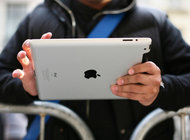PARIS — The music industry, the first media business to be consumed by the digital revolution, said Tuesday that its global sales had risen last year for the first year since 1999, suggesting that a long-sought recovery might have finally begun.
The increase, of 0.3 percent, was tiny, and the total revenue, $16.5 billion, was a far cry from the $38 billion that the industry took in at its peak more than a decade ago. Still, even if it is not time for the record companies to party like it’s 1999, the figures, reported Tuesday by the International Federation of the Phonographic Industry, are a significant psychological boost.
“It’s clear that 2012 saw the global recording industry moving onto the road to recovery,” said Frances Moore, chief executive of the federation, which is based in London. “There’s a palpable buzz in the air that I haven’t felt for a long time.”
For years, the music industry’s decline looked terminal, with the record companies seemingly unable to come up with legitimate digital business models that could compete with the lure of piracy. Last year, however, digital sales and other new sources of revenue finally grew significantly enough to offset the continuing decline in CD sales.
“At the beginning of the digital revolution it was common to say that digital was killing music,” said Edgar Berger, chief executive of the international arm of Sony Music Entertainment. “The reality is that digital is saving music.”
Digital revenue comes in a variety of forms. Sales of downloaded singles and albums, from services like Apple’s iTunes, continue to grow. More promising for the industry, however, are subscription-based services like Spotify, Rhapsody and Muve Music, which have attracted a combined 20 million users worldwide. Subscription fees and licensing revenue are both growing rapidly.
Performance remains highly uneven around the world. Eight of the 20 biggest music markets showed growth last year, but in some countries that the industry classifies as “emerging,” like Russia and China, piracy remains endemic and licensed, legitimate digital services struggle.
There are also worrying signs in some more developed markets that had previously been relatively robust, like Britain. There, the recent bankruptcy of the leading retail music chain, HMV, has prompted fears about an acceleration of the decline in CD sales.
In the United States, sales slipped slightly last year. But Enders Analysis, a research firm in London, predicted in a separate report published Tuesday that this year would mark the beginning of a turnaround, with revenue rising to $5.35 billion from $5.32 billion.
Alice Enders, a senior analyst at the firm, said growth in the coming years was likely to remain slow, as CD sales continue to plunge. Still, after more than a decade of falling revenue, the performance last year was encouraging for the industry.
“It’s huge,” she said. “It’s a milestone.”
Article source: http://www.nytimes.com/2013/02/27/technology/music-industry-records-first-revenue-increase-since-1999.html?partner=rss&emc=rss


